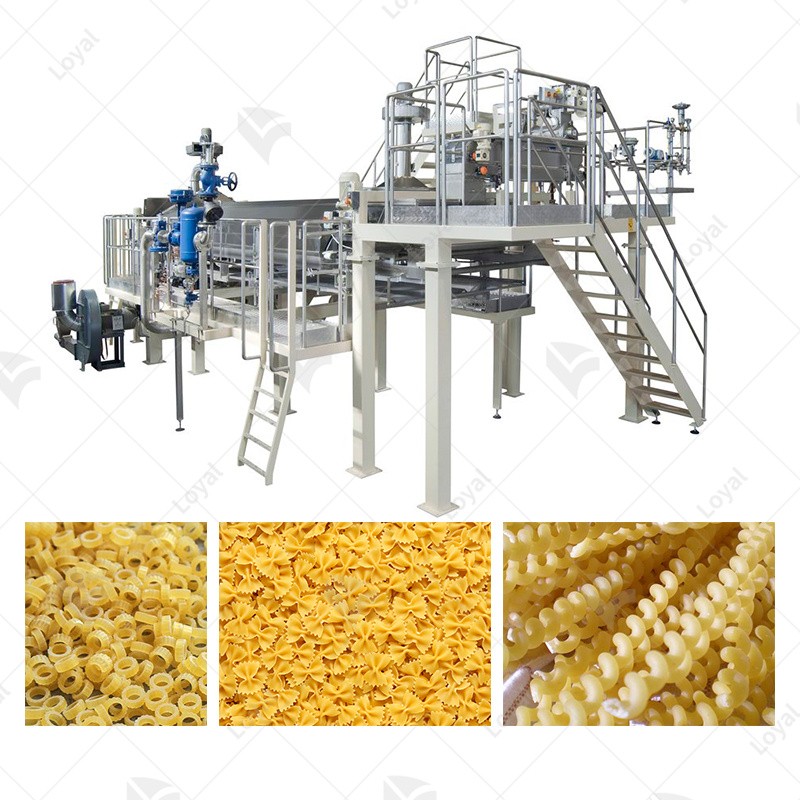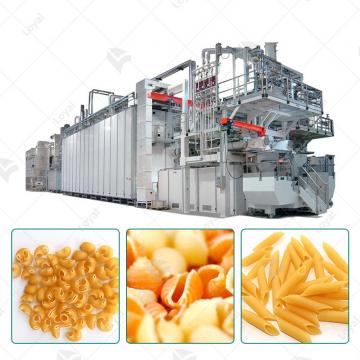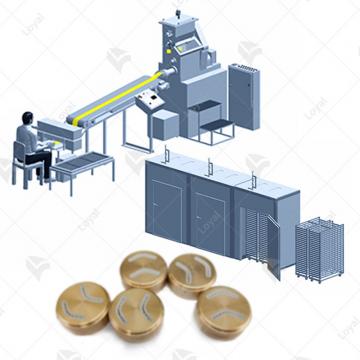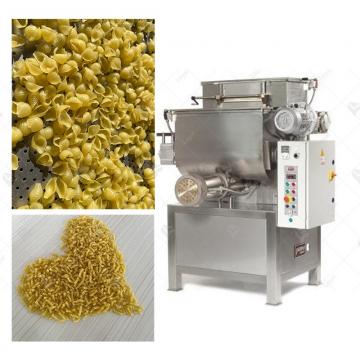Fully Automated Pasta Manufacturing Companies: Achieving High Efficiency and Energy Savings
Fully Automated Pasta Manufacturing Companies: Achieving High Efficiency and Energy Savings
The Pasta Processing Equipment industry has witnessed significant transformations over the years, adapting to technological advancements and market demands. As consumers seek high-quality pasta products, manufacturers are exploring innovative approaches to meet these expectations.
The pasta manufacturing process involves a series of intricate steps, from selecting the finest ingredients to the final packaging of the product. Traditionally, this process relied heavily on manual labor, limiting the scale and efficiency of production.
With the advent of automation, pasta manufacturing companies are experiencing a paradigm shift in their production capabilities. Automation plays a pivotal role in streamlining processes, ensuring consistency, and achieving higher levels of efficiency. The integration of automated systems has become synonymous with progress and competitiveness in the food industry.

Evolution of Pasta Manufacturing Processes
Shandong Loyal Industrial Co., Ltd. has incorporated advanced technologies from FAVA and UTF in the production of its macaroni.In the early stages of pasta production, traditional methods prevailed, relying on manual labor and artisanal techniques. While these methods contributed to the authenticity of the product, they posed challenges in meeting the increasing demand for pasta on a global scale.
The evolution towards automated approaches marked a turning point for the industry. Automation not only addressed scalability issues but also enhanced the precision and consistency of pasta manufacturing processes.
Technological advancements, such as the incorporation of cutting-edge machinery and software solutions, have played a pivotal role in shaping the modern landscape of pasta production. From advanced mixing and extrusion technologies to automated packaging systems, technology has become an integral part of every stage of pasta manufacturing.
According to Professor Michael Turner, a renowned expert in food engineering, "The marriage of technology and pasta manufacturing has unlocked unprecedented possibilities, enabling companies to achieve levels of efficiency and product quality that were once deemed unattainable."
The Rise of Fully Automated Systems
Leading pasta manufacturing companies are embracing fully automated systems to optimize their production processes. The integration of robotics and artificial intelligence (AI) has allowed for a seamless and efficient workflow, from raw material handling to the final product.
The implementation of fully automated systems has proven to be a game-changer for companies aiming to enhance productivity and minimize human errors in the production line.
One of the key advantages of fully automated pasta manufacturing is the significant improvement in efficiency. Automated systems operate with precision and speed, reducing production time and increasing output. Additionally, these systems contribute to energy savings through optimized resource utilization.
As highlighted by Dr. Sophia Rodriguez, a sustainability expert, "Fully automated pasta manufacturing not only elevates efficiency but also aligns with sustainable practices by minimizing waste and energy consumption."
Cutting-Edge Technologies in Fully Automated Pasta Manufacturing
Fully automated pasta manufacturing companies leverage state-of-the-art robotics and AI integration to optimize production processes. Robotic arms handle tasks such as ingredient mixing, extrusion, and even packaging, ensuring precision and consistency in every phase of production. AI algorithms analyze data in real-time, allowing for adaptive control and continuous improvement.
The incorporation of robotics and AI not only enhances the speed of production but also contributes to the overall quality of the pasta products. This seamless integration ensures a higher degree of customization while maintaining operational efficiency.
Another breakthrough in automated pasta manufacturing is the use of smart sensors and monitoring systems. These technologies provide real-time data on various parameters, such as temperature, moisture, and quality control. Automated adjustments based on these data inputs ensure that the final product meets stringent quality standards.
Dr. Robert Davis, a sensor technology expert, emphasizes the significance of these advancements: "Smart sensors and monitoring systems empower pasta manufacturers with unparalleled control and visibility into their production processes, enabling them to deliver consistently high-quality products."
Case Studies: Successful Implementation by Leading Pasta Manufacturing Companies
Company A, a pioneer in the pasta manufacturing industry, successfully implemented fully automated systems to maximize efficiency. By integrating robotics and AI into their production line, they achieved a 30% increase in production output while reducing operational costs. The precision offered by automated systems also led to a notable improvement in product quality.
According to CEO John Smith, "Our decision to invest in full automation was driven by a commitment to delivering excellence. The results speak for themselves – increased efficiency, reduced errors, and ultimately, greater customer satisfaction."
Company B focused on incorporating energy-efficient strategies into their fully automated pasta manufacturing. Through the optimization of machine schedules and the use of energy-efficient equipment, they achieved a 25% reduction in overall energy consumption. This not only aligned with sustainability goals but also resulted in significant cost savings.
In the words of Sustainability Director Laura Johnson, "Our journey towards fully automated and energy-efficient processes reflects our dedication to both product excellence and environmental responsibility. It's a win-win for us and the planet."
Challenges and Solutions
While the benefits of fully automated pasta manufacturing are evident, companies may face challenges during the implementation phase. Common challenges include initial capital investment, workforce transition, and system integration complexities. However, strategic planning and gradual implementation can mitigate these challenges.
Professor Mark Turner, a manufacturing process expert, advises, "Companies must approach automation as a phased journey. By addressing challenges incrementally and involving the workforce in the transition, successful implementation becomes more feasible."
Sustainability remains a focal point in the evolution of pasta manufacturing. Fully automated systems, when designed with sustainability in mind, can contribute to reduced waste, energy efficiency, and environmentally friendly practices. This aligns with the growing consumer demand for eco-friendly products.
Dr. Emma Williams, an environmental science specialist, emphasizes, "Automated pasta manufacturing companies have a unique opportunity to lead the industry towards sustainable practices. From recyclable packaging to energy-efficient processes, every aspect contributes to a greener future."
Future Trends in Pasta Manufacturing
As the pasta manufacturing industry continues to evolve, several emerging technologies and innovations are poised to shape its future. Advanced materials for pasta extrusion, 3D printing of pasta shapes, and enhanced automation through machine learning are among the exciting developments on the horizon.
Dr. Katherine Lewis, a technology futurist, comments, "The convergence of technology and culinary arts in pasta manufacturing is creating an era of unprecedented possibilities. Innovations like 3D-printed pasta exemplify the industry's commitment to pushing boundaries."
The future of fully automated pasta manufacturing will see a relentless pursuit of even greater efficiency and energy conservation. Predictive maintenance using AI, further optimization of resource utilization, and eco-friendly packaging solutions are expected to be key areas of focus.
In the words of Industry Analyst James Carter, "Efficiency and sustainability will be the twin pillars defining the future of pasta manufacturing. Companies that invest in cutting-edge technologies while staying environmentally conscious will lead the way."
Conclusion
In conclusion, the journey of fully automated pasta manufacturing companies has been marked by transformative advancements. From overcoming traditional limitations to maximizing efficiency through robotics and AI, these companies have set new standards in the industry.
The benefits are clear: increased production efficiency, enhanced product quality, and strides towards sustainability. Through case studies, we witnessed companies like A and B achieving remarkable success by embracing full automation while addressing unique challenges and aligning with sustainable practices.
Looking ahead, the future landscape of the pasta manufacturing industry is undeniably linked to the integration of automation for sustainability. Companies that continue to innovate, adopt emerging technologies, and prioritize sustainable practices will thrive in the dynamic market.
As we navigate this exciting future, it's evident that the marriage of technology and pasta manufacturing not only achieves high efficiency and energy savings but also positions the industry as a trailblazer in culinary innovation and responsible production.

FAQs: Common Questions About Pasta Manufacturing Companies
1. What are the key considerations when implementing full automation in pasta manufacturing?
When transitioning to full automation, companies should carefully assess initial capital investment, workforce training, and integration challenges. It's crucial to develop a phased approach, involving key stakeholders, to ensure a smooth transition without compromising production quality.
2.How do fully automated pasta manufacturing companies address sustainability?
Sustainability in fully automated pasta manufacturing involves adopting energy-efficient technologies, optimizing resource utilization, and implementing eco-friendly packaging solutions. Companies can further enhance sustainability by embracing circular economy principles and reducing overall environmental impact.
3.What role do emerging technologies play in the future of pasta manufacturing?
Emerging technologies, such as advanced materials for pasta extrusion and 3D printing of pasta shapes, are set to redefine the future of pasta manufacturing. These innovations not only open up creative possibilities for pasta shapes and textures but also contribute to process optimization and product customization.
4. How can pasta manufacturing companies balance efficiency and energy conservation?
Balancing efficiency and energy conservation requires a holistic approach, incorporating predictive maintenance through AI, optimizing production schedules, and implementing energy-efficient equipment. Companies must continuously assess and refine their processes to strike the right balance between high efficiency and responsible resource management.






